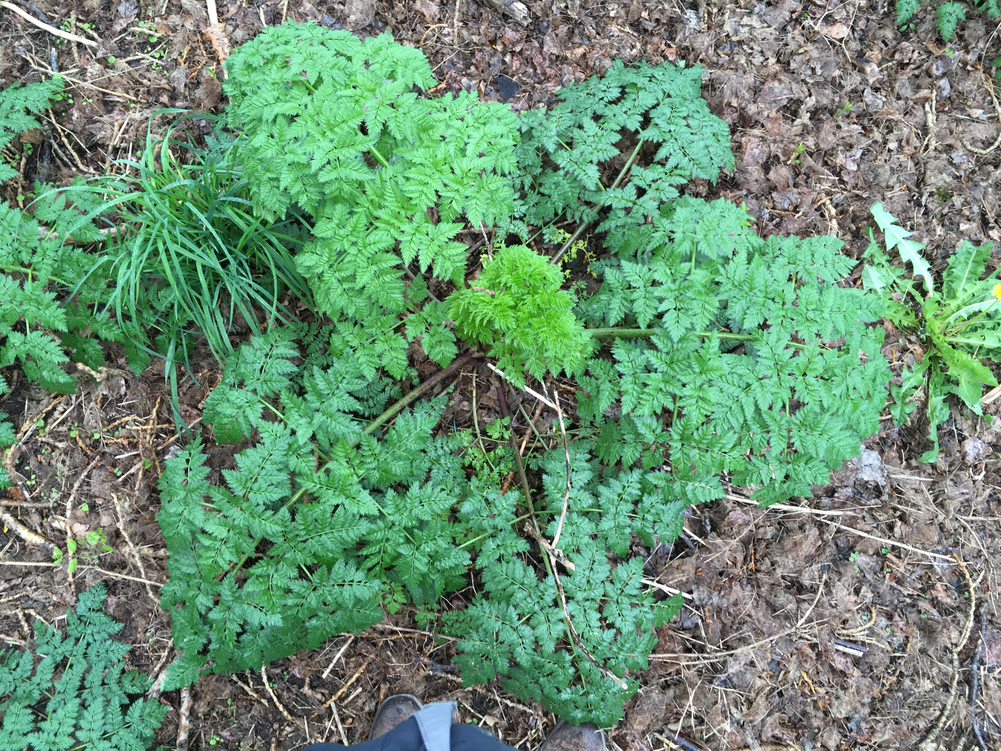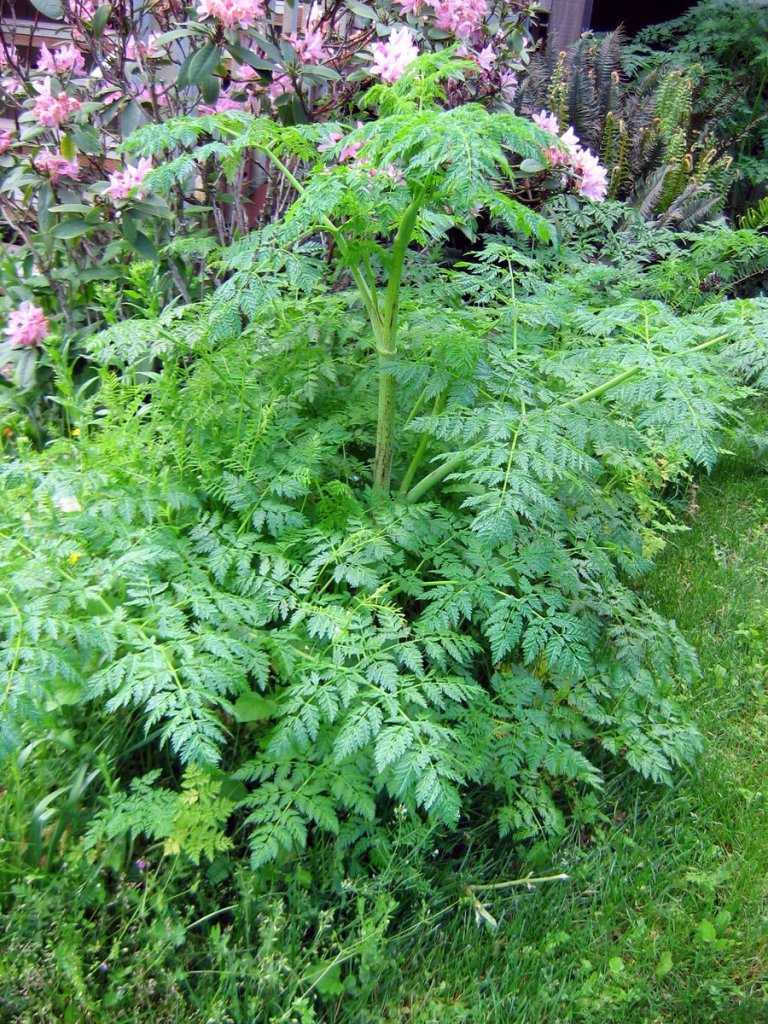Poison hemlock identification and control
Information about the toxic, noxious weed poison hemlock. Poison hemlock is also known by its Latin name, Conium maculatum.
About this weed
Poison hemlock is a Class B noxious weed with selective regulation in King County. This means control of poison hemlock is required on public lands and public rights-of-way. Private property owners are not required to control it on their lands, though it is highly recommended due to its invasive and toxic behaviors. Do not eat any part of this plant and be careful when handling it.
Poison hemlock is also on the Washington quarantine list.
Poison hemlock is known as Conium maculatum. It is a member of the carrot family. Other common names include poison parsley, deadly hemlock, spotted hemlock, wild hemlock, carrot fern, California fern, devil’s bread, and devil’s porridge.

Why it's a problem
Poison hemlock is a toxic plant in the carrot family introduced from Europe and now found throughout North America.
It spreads easily by seed to new areas and grows in dense, tall patches that exclude other vegetation. It is most often found in open sunny areas, fields, vacant lots, and on roadsides. Eating even a small amount of any part of this plant can kill people, livestock, and wildlife.
Plant description
Poison hemlock is native to parts of Europe and Asia. It is now found throughout North America. In King County, it grows along roadsides, trails, fields, yards, and vacant lots. It prefers damp soil and sun but can adapt to drier soil and shadier conditions.
Poison hemlock takes 2 years to mature, so plants will look different depending on which stage they are in. There are many similar plants that are edible or otherwise beneficial so look carefully at the plant parts to see if they match the description.
In all stages of growth, stems have red or purple spots and streaks, are not hairy, and are hollow. Leaves are bright green, fern-like, divided into small segments, and have toothed edges. Leaves are often compared to parsley plants and carrot tops (same family). Plants have a strong musty odor when crushed. There is typically one main tap root that looks like a white carrot. All plant parts are poisonous, do not consume any parts of this plant.
First year plants are low-growing and may live through the winter in mild climates. They can look like carrot plants, but the stems are hairless with purple-red blotches on the stems.
Second year plants grow 6 to 10 feet tall. Tiny umbrella-shaped clusters of white flowers, each with five petals, grow on ends of branched stems.
The plant reproduces by seed. It is a biennial (has a 2-year life span). It has rapid growth from March to May, and flowers in late spring.
Poison hemlock makes up to 40,000 seeds per plant. The seeds fall near the plant and move by erosion, animals, rain, and human activity. Seeds can live up to six years and sprout throughout the growing season.
After producing seeds, the plant slowly dies, leaving hollow brown stalks. New plants grow from seed and will show up around the base of the stalks as first-year rosettes in the fall.
Seeds typically start to form by early August. It is best to control these plants before they produce seeds.












Be aware of look-alike plants
Poison hemlock can be confused with many edible members of the parsley family including fennel, chervil and anise. Be sure you have correctly identified any plant before you eat it.
It can also be mistaken for several common noxious weeds.
To distinguish poison hemlock from other plants with fern like leaves, look for a completely smooth (hairless) stem with purple or red spots and streaks. It also tends to emerge earlier in the growing season (March - April) than other similar plants.
When in doubt, take photos and share them with us or report them on iNaturalist.
What to do if you find it
If you find poison hemlock on your own property, control it (using the methods listed in the Control methods section) and alert anyone using the property. This is especially important in areas that are accessible to people, pets, and livestock. Always wear gloves, long sleeves, and long pants when handling this plant.
Typically, skin contact alone will not cause enough of a reaction to require medical treatment. Sap may cause a serious reaction in some individuals. These individuals should seek medical help. Avoid skin contact by wearing proper protection. To be safe, wash any skin that has contacted the plant with soap and warm water as soon as possible.
Please report locations on public lands and roads. This is especially important in p-patch or community gardens where new gardeners or newcomers to our area may not know this plant.
Control methods
We recommend using a combination of methods to control noxious weeds. In areas with few weeds, it is important to act quickly before they become harder to control. Make a long-term plan as it often takes several years to get rid of most weeds. Start in the least infested areas first and then move into more heavily infested areas.
You should always wear gloves and long-sleeves when handling poison hemlock. Take frequent breaks when pulling or mowing large amounts of plants. It is not difficult to control poison hemlock, but you need to be careful to protect yourself.
Manual control
For smaller patches and individual plants, you can pull or dig up plants in any growth stage. Seedlings can be scaped out with a hoe. For any growth stage, try to remove entire root. This is easier in the spring and fall before the soil dries out. Wash your hands thoroughly after handling plants. If there is bare ground after plants have been removed, a 4-6” deep layer of mulch can help to prevent new poison hemlock seeds from sprouting.
Mechanical control
If you mow or weed whack poison hemlock, you can breathe in toxins or get bits of plant material in your mouth. Cover your mouth and nose with a mask if you need use these control methods. Stop if you feel sick. Plants that are mowed are likely grow back and flower again that same year, you will need a follow up control method like digging or herbicide treatment.
Chemical control
Stay safe when using herbicide:
- Always read the label before use.
- Wear a long-sleeved shirt, long pants, shoes, and eye protection.
- Follow state and local regulations.
For larger areas, you may want to consider using an herbicide. Chemical control is most effective if done before poison hemlock begins to flower, in early to late spring and again in the fall. Apply herbicide to the entire leaf and stem surface of actively growing plants. Wait at least 14 days before cutting any treated plants, to give the herbicide time to work. Glyphosate (non-selective) is effective for poison hemlock that is not growing with grasses. Triclopyr (broadleaf selective) is a better choice for grassy areas. Seeds can germinate throughout the season, so repeat treatments may be required to get rid of all plants. You can also combine chemical control with other methods.
See the PNW Pest Management Handbook for more information on chemical control of poison hemlock.
Chemical control options may differ for private, commercial, and government agency users. For more information, or a site-specific recommendation in King County, contact the noxious weed program. For information in other locations, contact your local weed board or extension office.
Disposal instructions
Place in a plastic trash bag and discard with regular trash. Do not put poison hemlock in yard waste or compost bins. If necessary, you can pile up the plants where you pulled them and leave them to decompose. Limit public access to the pile because the plant material is toxic if ingested. Do not dump in parks or open space.
Noxious Weed Disposal - Washington State Noxious Weed Control Board
Learn more about poison hemlock
Read poison hemlock fact sheet (322KB)
This fact sheet is also available in these languages:

 Translate
Translate